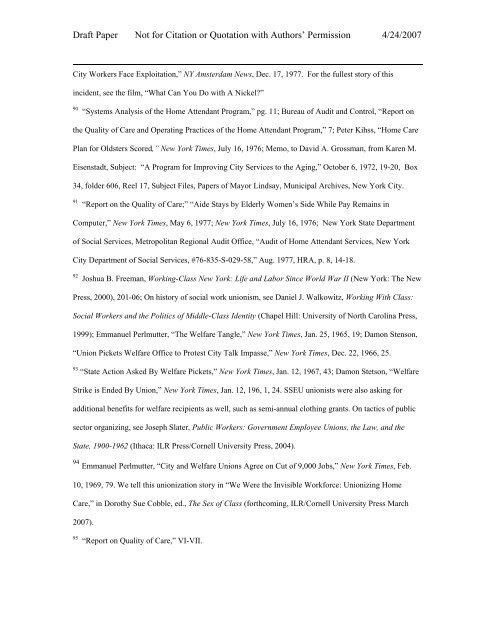Organizing Home Care: - School of Social Service Administration
Organizing Home Care: - School of Social Service Administration
Organizing Home Care: - School of Social Service Administration
Create successful ePaper yourself
Turn your PDF publications into a flip-book with our unique Google optimized e-Paper software.
Draft Paper Not for Citation or Quotation with Authors’ Permission 4/24/2007<br />
City Workers Face Exploitation,” NY Amsterdam News, Dec. 17, 1977. For the fullest story <strong>of</strong> this<br />
incident, see the film, “What Can You Do with A Nickel?”<br />
90 “Systems Analysis <strong>of</strong> the <strong>Home</strong> Attendant Program,” pg. 11; Bureau <strong>of</strong> Audit and Control, “Report on<br />
the Quality <strong>of</strong> <strong>Care</strong> and Operating Practices <strong>of</strong> the <strong>Home</strong> Attendant Program,” 7; Peter Kihss, “<strong>Home</strong> <strong>Care</strong><br />
Plan for Oldsters Scored,” New York Times, July 16, 1976; Memo, to David A. Grossman, from Karen M.<br />
Eisenstadt, Subject: “A Program for Improving City <strong>Service</strong>s to the Aging,” October 6, 1972, 19-20, Box<br />
34, folder 606, Reel 17, Subject Files, Papers <strong>of</strong> Mayor Lindsay, Municipal Archives, New York City.<br />
91 “Report on the Quality <strong>of</strong> <strong>Care</strong>;” “Aide Stays by Elderly Women’s Side While Pay Remains in<br />
Computer,” New York Times, May 6, 1977; New York Times, July 16, 1976; New York State Department<br />
<strong>of</strong> <strong>Social</strong> <strong>Service</strong>s, Metropolitan Regional Audit Office, “Audit <strong>of</strong> <strong>Home</strong> Attendant <strong>Service</strong>s, New York<br />
City Department <strong>of</strong> <strong>Social</strong> <strong>Service</strong>s, #76-835-S-029-58,” Aug. 1977, HRA, p. 8, 14-18.<br />
92 Joshua B. Freeman, Working-Class New York: Life and Labor Since World War II (New York: The New<br />
Press, 2000), 201-06; On history <strong>of</strong> social work unionism, see Daniel J. Walkowitz, Working With Class:<br />
<strong>Social</strong> Workers and the Politics <strong>of</strong> Middle-Class Identity (Chapel Hill: University <strong>of</strong> North Carolina Press,<br />
1999); Emmanuel Perlmutter, “The Welfare Tangle,” New York Times, Jan. 25, 1965, 19; Damon Stenson,<br />
“Union Pickets Welfare Office to Protest City Talk Impasse,” New York Times, Dec. 22, 1966, 25.<br />
93 “State Action Asked By Welfare Pickets,” New York Times, Jan. 12, 1967, 43; Damon Stetson, “Welfare<br />
Strike is Ended By Union,” New York Times, Jan. 12, 196, 1, 24. SSEU unionists were also asking for<br />
additional benefits for welfare recipients as well, such as semi-annual clothing grants. On tactics <strong>of</strong> public<br />
sector organizing, see Joseph Slater, Public Workers: Government Employee Unions, the Law, and the<br />
State, 1900-1962 (Ithaca: ILR Press/Cornell University Press, 2004).<br />
94 Emmanuel Perlmutter, “City and Welfare Unions Agree on Cut <strong>of</strong> 9,000 Jobs,” New York Times, Feb.<br />
10, 1969, 79. We tell this unionization story in “We Were the Invisible Workforce: Unionizing <strong>Home</strong><br />
<strong>Care</strong>,” in Dorothy Sue Cobble, ed., The Sex <strong>of</strong> Class (forthcoming, ILR/Cornell University Press March<br />
2007).<br />
95 “Report on Quality <strong>of</strong> <strong>Care</strong>,” VI-VII.
















